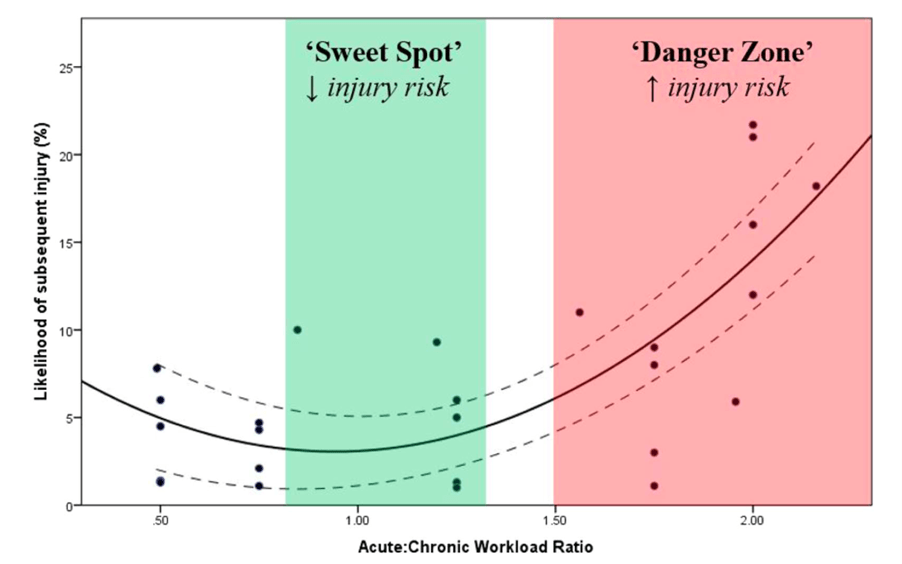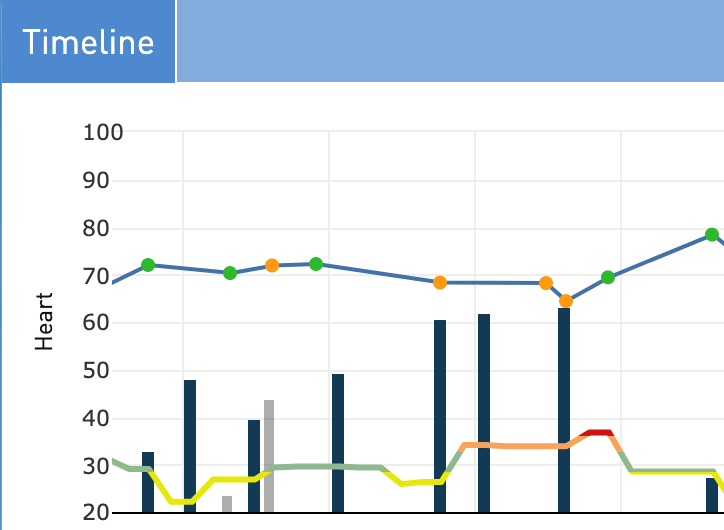
Do you know how to safely and objectively increase your training load?
ithlete Pro provides a very useful analysis of your recent training history, using an indicator known as the ‘Acute to Chronic training load ratio’. Import your training load from Training Peaks or Garmin Connect and ithlete Pro will deliver you colour-coded actionable guidance showing whether or not you’re risking over/under training.
What is the acute-to-chronic training load ratio?
The acute to chronic training load ratio (ACL) is a metric used in exercise and sports science to monitor the balance between recent training load and the overall training load over a longer period of time.
Based on scientific research (Gabbett et al.) ongoing across a range of sports, the Acute to Chronic load ratio can be thought of as a more advanced form of the old advice to runners ‘not to increase mileage by more than 10% each week’. The basic idea is that there is a sweet spot of lower risk when you maintain training at similar levels and only change gradually from one week to the next. Increase the training load too quickly and you risk injury and overtraining, not increasing enough will prevent adaptation and progress.
How is the acute-to-chronic training load ratio calculated?
Your Acute to Chronic training load is calculated by dividing the acute training load (the load in the past week or two weeks) by the chronic training load (the load over the past 4-12 weeks).
- A high ACL ratio indicates a sudden increase in the training load, which can put the athlete at risk of overtraining or injury.
- On the other hand, a low ACL ratio indicates that the training load has not been sufficient to create an adaptation.
- An ACL ratio within the optimal range (green in the chart below) suggests that the training load is appropriate and sufficient to promote adaptation without causing harm.
The ACL ratio is a useful tool for coaches, trainers, and athletes to monitor the progression of training and ensure that the training is well-balanced and not leading to overtraining or injury.
Dr Gabbett’s studies show this relationship as follows:

If you were to increase your training load by, for instance, 10% every week for 4 weeks, you would end up with a ratio of 1.15. This would keep you in the ‘sweet spot’ and so minimise the risk of injury as shown in the chart above.
The acute to chronic training load ratio in ithlete Pro
This is quite a calculation to do yourself and would need to be done constantly as you perform each training session. That’s where ithlete can help. If you import your training data from Training Peaks or Garmin Connect then ithlete Pro will do the math for you and give you an easy-to-follow colour-coded summary.
We have implemented this Acute to Chronic training load ratio using the average training load over the past 7 days (the acute component), and the average of the last 4 weeks as the (chronic component).
A value of 1.0 indicates that your training has been constant for the past 4 weeks, whereas a value of 1.2 indicates you have experienced a 20% increase in the past week compared to the average of the past 4 weeks. This information is colour coded to make it really easy to follow!
ithlete Pro uses a 7-day rolling average of your training load data and coloured that line according to your ACL ratio so that:
- green indicates you are in the optimal load zone
- orange indicates you are increasing load a little too rapidly (ACL between 1.2 and 1.5). This is okay in the short term but you should be aware that there is an increased risk of injury.
- red indicates your training load is increasing at a rate that is likely to lead to overuse injury or illness.
- yellow, on the other hand, indicates that your recent training load is probably too low to stimulate adaptation. You can normally expect to see this during periods of low/no training e.g. after a big event or during sickness.
The ithlete Pro timeline example below (taken from the web app) shows a period where, starting from an optimal base, individual day’s loads (black bars) are both higher and more frequent than the athlete is used to. After the intense period was stopped and the athlete focussed on recovery, the HRV trended strongly upward, indicating super compensation to a higher fitness level.

Summary
Guiding your training load with the acute to chronic training load ratio is a great way to avoid over/under training and minimise the risk of injury. Using ithlete Pro’s acute to chronic training load tool automates this process for you, delivering easy-to-follow colour-coded guidance.
Try it yourself!
The acute to chronic training load calculator is just one of the excellent features you can find in ithlete Pro.
You can sign up for a no-obligation 28-day trial below – all you need to do is enter is your email address.

I signed up and have the free trail for 28 days. I am also syncing with Garmin connect. However, I cannot see my acute to chronic ratio in my training charts. Can you please review and let me know why is this ratio not appearing. Thanks
Hi Raheel,
I’ve sent you an email requesting access to your data so we can look into this further.
Many thanks,
Laura
i am using Pro, and have had ACL show on graph but for some reason now it is not??
Hi Lindy,
Some users have reported a problem with syncing their TrainingPeaks data to ithlete Pro. Although their HRV and wellness metrics are appearing in their TP dashboard, their daily TSS scores are not appearing in the ithlete Pro timeline.
We have reported this problem to TrainingPeaks, and they have said they are looking into it for us now.
As a temporary workaround, you can enter your TSS total for the previous day when you do your morning HRV measurement. It will appear as a grey bar in the timeline chart, but will not be included in your Acute: Chronic TL ratio calculation. That will be updated when this import issue is corrected.
In the meantime, we apologise for the inconvenience.
Best, Laura
I have recently started trying out the pro version after several years on another platform. I have a difficult question.
I am 69 years old. I have an autoimmune neuromuscular disease called Myasthenia Gravis.
I am steroid dependent ant take 20 mg of prednisone per day (approximately 4x normal cortisol levels). As a result there will be no cortisol spike as the hypothalamus-pituitary axis is suppressed
I have always taken my HRV after my medications and morning coffee.
I have started to experiment with taking readings before getting out of bed. They are 15-20 lower than when I repeat them after my meds/coffee.
What can you tell me about the impact of cortisol on HRV? I am not “normal”, because I have none.
What do you think the pro’s and con’s of taking my HRV as I have been doing… vs shifting to a time where I will have little or no steroid effect?
I still use RPE, acute vs chronic training load and enthusiasm for training as guides… but it’s hard to know sometimes.!
Hi Steve,
Apologies for the slow reply as I’ve been on summer vacation for a few weeks!
After the usual cautions that we are not qualified to give medical advice, I would say that, as described in this article https://www.myithlete.com/time-of-measurement/ it is important to perform your HRV measurements at the same point in your daily cycle. For you, the best time may well be after your medications and morning coffee in the sitting or standing position. After nearly 15 ys of measuring HRV, I’m convinced that measures taken this way are more sensitive to multiple forms of stress than those taken lying down. Cortisol normally acts to reduce HRV as it’s a sympathetic stimulant (ie it acts counter to parasympathetic stimulation that modulates HRV positively).
Have you discovered a good routine since you wrote the post? If so, it would be good to hear about it so others can benefit.
Best wishes, Simon